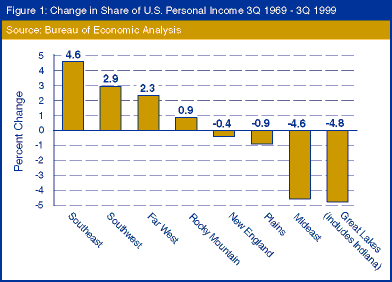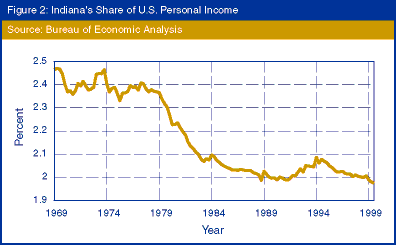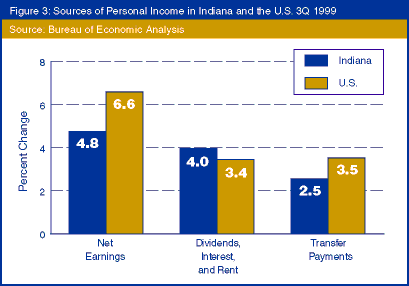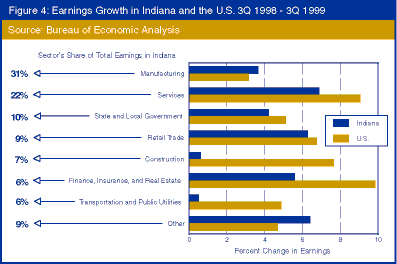Kelley School Forecasts Growth, Notes Risks
Strong economic growth is likely to continue in both Indiana and in the United States as a whole, according to the latest quarterly forecast from the Kelley School of Business at Indiana University.
The Kelley School's Center for Econometric Model Research in Bloomington notes that the U.S. gross domestic product grew at an annual rate of 6.9% in fourth quarter 1999. For the year 2000, the Center's forecast released at the end of February predicts slightly slower but still healthy growth. U.S. growth will ease to 2.8% during 2000. Exports should expand, while both consumption and equipment investment are forecast to grow more slowly than in 1999.
The Fed will continue to raise interest rates this year, and inflation will remain low, only moderately above 1999's 2% rate. Construction activity, however, will decline compared to 1999—due mainly to higher interest rates. Residential investment nationwide rose last year. This year it is forecast to fall 2% from 1999 levels.
Indiana will enjoy the continuing expansion, though growth rates here are likely to be just under those in the nation as a whole. The model predicts real personal income will increase by 3.7% in the U.S. this year and 3.2% in Indiana. Non-farm establishment employment is forecast to be up 1.8% in the U.S. and 1.2% in Indiana. Non-manufacturing employment will grow in the state, but that will be offset by flat or declining employment in Hoosier manufacturing.
What could derail this happy picture? Oil prices have jumped in recent weeks, but those increases shouldn't hurt the overall conditions. Dr. Jeffery Green is professor of business economics and public policy and associate dean for research and operations in the Kelley School at IU and heads the econometric modeling center. Dr. Green believes current oil prices won't slow things much.
"Certain industries, like airlines, get hit when oil prices go up," said Dr. Green. "But in general, the number of barrels of oil per dollar of GDP has been falling. So the economy isn't as sensitive to higher oil prices. If prices continue to rise, though, beyond $30 per barrel, that may well put a damper on consumer spending."
A bigger factor in the outlook may be the unpredictable stock market. Said Dr. Green, "Our research shows a wealth effect from rising equity prices to be a factor in consumer spending. If the stock market takes a big drop and stays down, we'd expect to see much slower growth."
Personal Income Increases, But at a Slower Rate than the Nation
The latest earnings data from the U.S. Bureau of Economic Analysis show Indiana's total personal income at $150 billion, the 16th largest economy in the nation. Between the third quarter of 1998 and the same quarter in 1999, Indiana's personal income grew by 4.3%. During the same period, the Great Lakes states grew by 5.2% and the nation by 5.6%.
Indiana's current rate of personal income growth is consistent with recent and long-term trends for the state and the region. The five-state Great Lakes region has seen a decline in its share of the nation's income in each of the past three decades (see Figure 1).

The intense global competition beginning in the 1970s within the manufacturing sector has hit both the Great Lakes and Mideast regions particularly hard. Prior to this period, the Great Lakes contributed 21% to the nation's personal income, exceeded only by the Mideast region at 24%. Today, the Great Lakes contribute 16%, less than the Southeast, Mideast and Far West regions. Indiana's share of the nation's personal income has similarly moved from 2.47% in the third quarter of 1969 to 1.97% in the same quarter of 1999 (see Figure 2).

Personal income is made up of earnings, returns to wealth, and transfer payments. Earnings (what we make as the result of working for ourselves or for someone else) in Indiana are not rising as rapidly as in the rest of the nation (see Figure 3).

Because earnings constitute approximately 70% of all personal income, this 1.8% differential (Indiana 4.8% vs. the nation at 6.6%) dominates the offsetting effects of other income components. Hoosiers are doing better than the nation in returns to wealth (dividends, interest and rent) but not as well in transfer payments (largely Social Security). But each of these components accounts for just 15% of personal income and is less subject to state and individual policy decisions.
To understand Indiana's earnings growth, consider Figure 4 below, where the various sectors of the economy are shown in descending order of importance to the state. Manufacturing leads the list, accounting for 31% of all earnings, followed by services with 22% of Hoosier earnings. In terms of growth, Indiana earnings have increased faster than the nation in two of the eight sectors shown. Together, these two sectors account for 40% of Indiana's economy, but their combined advantage did not offset slower growth in the service and construction sectors. Indiana also grew more slowly in finance, insurance and real estate and in transportation and public utilities. As manufacturing continues to be restructured by global competition, our personal income growth will be linked to Indiana's (and the region's) ability to continue its shift to advanced manufacturing and other major sectors not historically centered in the Midwest.

